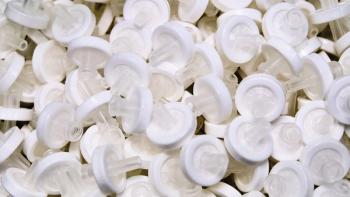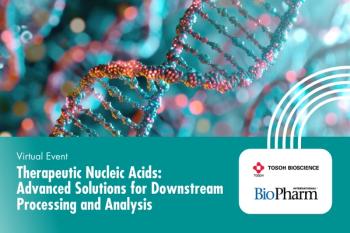
- BioPharm International-08-01-2010
- Volume 23
- Issue 8
Technical and Economic Benefits of Membrane Chromatography During Polishing Steps
An analysis of flow rate, load density, viral clearance, and cost.
ABSTRACT
There has been a rapid uptake of disposable technologies in the biopharmaceutical industry over the last decade, including disposable modules for chromatography. Disposable membrane chromatography has proven to be a powerful alternative to polishing columns, particularly for process-scale monoclonal antibody purification, because of advantages such as high throughput, faster processing time, reduced buffer consumption, and elimination of column packing and packing testing activities. Disposable technologies also allow facilities to run multiple products in a single plant without the risk of cross-contamination between batches. This article demonstrates through, a case study, the practical and economic benefits gained from replacing reusable column chromatography with disposable membrane chromatography. The study looks at the whole process and evaluates the production costs for the stainless steel option, in which all unit operations are performed using stainless steel equipment items, and the disposable option, in which column chromatography is replaced by disposable membrane chromatography and all other unit operations are based on stainless steel equipment items.
Significant upstream process advancements in the biomanufacturing industry have led to high cell culture titers producing a large mass of proteins. But we haven't seen the same improvement downstream, which now has to handle the elevated protein concentration and contaminant level. It has been much discussed in the literature that specific unit operations, such as traditional chromatography, can represent technological bottlenecks caused by dimension limitations.1,2 The improvement in titer affects production and material costs as the buffer, cleaning, and sanitization solutions required for downstream operations increase in proportion to the mass of product being purified.3 Therefore, large upstream protein production levels combined with the large scale demand of antibody-based therapeutics have driven the biopharmaceutical industry to search for alternate technologies to surmount the bottleneck downstream and fulfill the requirements for high-throughput production while delivering a product with high purity.2,4
SARTORIUS STEDIM BIOTECH
Manufacturers are exploring multiple ways of streamlining product recovery and purification processes. Strategies include standardized platform approach to downstream processes,5 and the evaluation of alternatives to chromatography separations to overcome the physical limitations of traditional chromatography.6,7 Among the novel technologies developed, membrane chromatography has already proven to be a robust alternative to columns, especially anion exchange chromatography (AEX) for polishing.
AEX chromatography is perhaps the most powerful tool to remove a variety of viruses, DNA, and endotoxins.8 In most cases, AEX chromatography is carried out using flow through (FT) mode, with the impurities binding to the chromatographic support and the product and the product of interest flowing through.
Replacing AEX column chromatography with AEX membrane chromatography has resulted in similar viral clearance at a much higher flow rate and load density compared with columns. Arunakumari, et al., recently reported >4 logs of minute mouse virus (MMV) and murine leukemia virus (MuLV) removal using Sartobind Q membrane adsorbers (Sartorius Stedim Biotech) in monoclonal antibody (MAb) processes at a load density of up to 20 kg MAb/L of membrane.9 The diffusion dependence and pressure limitation associated with column chromatography significantly limit throughput at large scales and lead to column oversizing in traditional polishing scale up. Because of the hydrodynamic benefits, membrane chromatography involves much smaller devices than columns with a similar output and no bottlenecks.1,2,10 Such disposable technology offers the added advantages of reducing buffer volume, processing time, and floor space requirement. Membrane chromatography is a disposable operation system; there is no need for column hardware, packing-related studies, resins life studies, carry-over studies, cleaning-in-place (CIP) and steaming-in-place (SIP) procedures, and validation. Membrane chromatography offers easy solutions to biomanufacturing, increases flexibility, and lowers capital requirements—all of which are benefits derived from disposable technology.
Whereas the disposable approach has been accepted for many years for operating certain unit operations in upstream and downstream processes such as cell harvest, filtration, and buffer and media storage, an increased trend toward disposable technologies only has been observed in the last five years in response to the needs of biopharmaceutical companies. In an effort to increase capacity without exposure to excessive investment risk, biopharmaceutical companies are considering disposable manufacturing.11 The economic benefits of single-use membrane chromatography for polishing as a single unit operation has been demonstrated.12 In this paper, we analyze the cost impact of replacing reusable chromatography technology with single-use membrane chromatography technology in the FT mode for the AEX polishing step, looking at the overall cost of goods (CoG) and the breakdown of the CoG into different categories (i.e., capital charges, materials, and consumables). The FT AEX polishing step was implemented as a unit operation in the whole process at a production scale of 2,000 L. The study evaluates the production costs for the whole process based on all stainless steel equipment and compares it to the process in which the Q column is replaced by the Q membrane capsule.
DISPOSABLE FT-AEX MEMBRANE CHROMATOGRAPHY FOR POLISHING
AEX resins typically are used as a polishing step in a FT mode for contaminant removal. Because the AEX resins remove only trace level of impurities, in principle, a small column should be significant to meet the impurity clearance requirements. However, the columns usually are over-sized at the manufacturing scale to meet process throughput requirements. AEX membrane chromatography provides an attractive alternative because of its convective mode of mass transport, which allows operation at a significantly higher linear flow-rate or smaller residence time than columns. The convective mode of mass transport coupled with the need for trace levels of impurity clearance enables the use of a membrane chromatography adsorber that is significantly smaller in size than a conventional column, which reduces buffer requirements.
Zhou and his collaborators at Amgen have extensively studied the membrane chromatography technology using Sartobind membrane capsules.13,14 The authors estimated water and buffer consumption comparing a stainless steel column to disposable membrane chromatography during polishing steps for contaminant removal and virus clearance in MAb purification processes. The authors observed a 95% buffer savings with the FT membrane chromatography as compared to traditional column chromatography, regardless of the production scale.15 The buffer and water consumption did not include buffers for column packing and validation incurred with resin reuse. At the 2,000-L scale, a 35-L column was necessary to accommodate the throughput, whereas a 0.18-L membrane volume was sufficient to clear contaminants and pathogens and achieve the required product purity. The smaller membrane chromatography device provides product of the same quality while reducing floor space requirements, hardware equipment, processing time, and labor use.
EVALUATION METHODOLOGY
Figure 1 shows BioSolve (Biopharm Services, Ltd.), the Excel-based model that was used in this study. Models are useful tools to define process performance and gain insight into process fit in the confines of an existing plant. Of course, they only provide an approximation—a model of the real situation limited by the information available for input. The use of the model provides an estimation of CoG and CoG breakdown by cost categories. In the model, the CoG takes into consideration the fixed overheads of the facility and the variable operations costs of the process. The fixed overheads include capital charges, taxes, and insurance, whereas the variable costs include materials, consumables, labor, and waste management.12,16
Figure 1. BioSolve model used to estimate total CoG and CoG breakdown by cost categories. Data provided by Biopharm Services.
Figure 2 depicts the framework of BioSolve, which comprises the user interface, process definition, productivity levels, cost calculations, and outputs. The interface provides a list of predefined key input parameters (e.g., process scale, expression level, solution preparation basis, single-user options) that enable the user to perform quick what-if analyses for different scenarios. The process information is defined in the cost model, which consists of the sequence of unit operations, mass and volume balances, equipment sizing, process operating conditions, and resource allocation. The model computes the facility throughput, equipment list, materials and consumables usage, and labor requirements. The model outputs include plant productivity, bill of materials and consumables, capital expenditure, and CoG.
Figure 2. Framework of the BioSolve model. The model comprises the user interface, process definition, productivity, cost calculations, and output.
CASE STUDY BACKGROUND
In this study, we evaluate the total CoG when the reusable AEX column chromatography was replaced by disposable membrane chromatography in a production process. The production process included upstream, recovery, and purification, and all unit operations were based on stainless steel equipment with the exception of the disposable Q membrane step in the disposable option (Figure 3). The process sequence was based on the manufacture of a mammalian-based MAb using generic production steps, derived from commercially relevant operations commonly practiced in the industry.
Figure 3. Sequence of unit operations for a typical MAb production process
The mammalian production cell culture is performed in fed-batch mode with two batch seed cell culture steps. The growth and production medium is DMEM medium with additives. The feeds are glucose and glutamine solutions. Removal of the cells is achieved by centrifugation and depth filtration. The downstream purification steps are standard industrial unit operations for the production of an antibody-based product, using routine solutions and cycle times.
The study assumes a 2,000 L process scale with 2 g/L MAb expression titer. Table 1 shows the feed mass (3,027 g) into the AEX chromatography unit operation. Load densities of 10 kg/L for the membrane adsorbers and up to 100 g/L for the Q-column were selected. Both devices were used in the FT mode. With these assumptions, 3,027 g of product would require a 20-inch Sartobind Q capsule with 360 mL membrane volume against a 30-L column volume (20 cm bed height) of Q sepharose FF (GE Healthcare Bio-Sciences Corp.)
Table 1. Mass balance calculations
The basis for the case study comparison is the steps used to define the chromatography operation (flush, equilibration, and wash). The buffers used for the disposable membrane operation are similar to that in the conventional resin-based chromatography case. Table 2 shows the subunit operations and the solution requirements for (a) the reusable column chromatography and (b) the disposable membrane chromatography. The stainless steel chromatography column requires cleaning and storage steps. The disposable nature of the membrane technology has eliminated the need for cleaning and washing, thereby reducing the amount of solutions required.
Table 2. Subunit operation steps for a) reusable resin-based chromatography and b) disposable membrane chromatography
COG WITH DISPOSABLE MEMBRANE CHROMATOGRAPHY
When the process is based on stainless steel equipment including reusable resin chromatography column, the overall CoG is $192/g of MAb. The CoG decreases to $184/g when reusable resin is replaced by disposable membrane chromatography (Figure 4). The need for capital requirement is reduced in the membrane chromatography option with 3% capital savings. Disposable membrane chromatography simplifies hardware installation, adding flexibility to the process. Despite a 0.3% increase in consumable cost, the overall CoG savings with disposable membrane chromatography is 4% because of reduced capital requirements, labor, and buffer and water consumption. The disposable chromatography option has the advantage of switching some of the capital costs to consumables costs that are only relevant when the plant is operational.
Figure 4. CoG results for a typical 2,000 L scale production process based on stainless steel equipment using reusable resin and when resin is replaced by disposable membrane chromatography.
Figure 5 represents the water and cleaning material usage with the Q membrane and Q resin. As we looked at the whole process, the buffer savings from the membrane is minimized because of the elimination of the CIP and SIP requirements that must be performed on the stainless steel-based equipment. A 3% water usage savings is observed with the membrane technology.
Figure 5. Water usage for a 2,000 L scale production process based on stainless equipment using reusable resin and when resin is replaced with disposable membrane chromatography.
ENVIRONMENTAL EFFECT OF DISPOSABLE TECHNOLOGIES
The increasing interest in disposable technology naturally has been followed by a growing concern about the environmental impact because of the solid plastic waste being generated from their use. Sinclair, et al., have compared the environmental footprint of a traditional biopharmaceutical manufacturing facility using fixed-in-place stainless steel equipment and a facility implementing disposable technologies.17 This paper demonstrated that the overall waste streams were reduced with disposable technologies, specifically water load and people requirements. A 25.5% reduction in CO2 emissions was estimated for the facility using disposables relative to the traditional stainless steel-equipped facility. The reduction in CO2 emission mainly is derived from the reduced usage of water, which more than compensates for the emission of CO2 associated with the use of plastics (i.e., between polymerization, transportation, and incineration).
CONCLUSIONS
Disposable membrane chromatography significantly reduces the need for water load. Water and buffer usage is 95% less for disposable membrane chromatography because there are no CIP or SIP procedures. Because of its hydrodynamic benefits, membrane adsorbers can operate at much higher flow rate or lower residence time than columns, thereby shortening the overall process time and reducing labor requirements and energy consumption. The smaller membrane device sufficient to process the required throughput reduced the plant footprint and operating costs.
The availability of membrane chromatography as prepacked, disposable, and portable capsules eliminates the need for packing and packing testing, cleaning, and cleaning validation, and adds safety to the product by preventing cross-contamination.
Interest in membrane chromatography has grown because it can be used as a disposable device while maintaining product with the required purity; and it has been much discussed in the literature that single-use system has lower an environmental impact.17,18
Nathalie Fraud, PhD, is senior scientist, purification technologies, at Sartorius Stedim North America, Bohemia, NY, 626.241.2171
REFERENCES
1. Gottschalk U. Bioseparation in antibody manufacturing: the good, the bad, and the ugly. Biotechnol Prog. 2008;24:496–503.
2. Davis J. A purification platform for the production of mAbs from fermenters with titers of 5 g/L and beyond. BioPharm Int. 2009 Oct Supplement:20–3.
3. Davis J. Economics of Monoclonal Antibody Production; the relationship between upstream title and downstream costs. IBC San Diego 2008.
4. Low D, O'Leary R, Pujar NS. Future of antibody purification. J Chromatogr B. 2007;848:48–63.
5. Schukla A, Hubbard B, Tressel T, Guhan S, Low D. Downstream processing of monoclonal antibodies—application of platform approaches. J Chromatogr B. 2007;848:28–39.
6. Thoemmes J, Etzel M. Alternatives to chromatographic separations. Biotechnol Prog. 2007;23:42–5.
7. Przybycien TM, Pujar NS, Steele LM. Alternative bioseparation operations: life beyond packed-bed chromatography. Curr Opin Biotechnol. 2004;15:469–78.
8. Fraud N. Membrane chromatography: an alternative to polishing column chromatography. Bioproc J. 2008;7:34–7.
9. Arunakumari A, Wang J, Ferreira G. Advances in non-Protein A purification processes for human monoclonal antibodies. BioPharm Int. 2009 Mar Supplement:22–6.
10. Gottschalk U, Fischer-Fruehholz S, Reif O. Membrane adsorbers, a cutting edge process technology at the threshold. BioProc Int. 2004;2:56–65.
11. DiBasi K, Jornitz M, Gottschalk U, Priebe PM. Disposable biopharmaceutical processes—myth or reality? BioPharm Int. Nov 2006.
12. Lim JA, C, Sinclair A, Kim DS, Gottschalk U. economic benefits of single-use membrane chromatography in polishing—a cost of goods model. BioProc Int. Feb 2007;48–56.
13. Zhou JX, Tressel T. Basic concepts in Q membrane chromatography for large-scale antibody production. Biotechnol Prog. 2006;22:341–9.
14. Zhou JX, Tressel T, Gottschalk U, Solamo F, Pastor A, Dermawan S, Hong T, Reif O, Mora J, Hutchison F, Murphy M. New Q membrane scale-down model for process-scale antibody purification. J Chromatogr A. 2006;1134:66–73.
15. Zhou J, Tressel T, Guhan S. Disposable chromatography. Single-use membrane chromatography as a polishing option during antibody production is gaining momentum. Biopharm Int. 2007, Supplement Feb. 26–35.
16. Lim JAC, Sinclair A. Process economy of disposable manufacturing—process models to minimize upfront investment. Amer Pharmaceut Rev. 2007;10:114–21.
17. Sinclair A, Leveen L, Monge M, Lim J, Cox S. The Environmental Impact of Disposable Technologies. Can disposable technology reduce your facility's environmental footprint? BioPharm Int. 2008 Nov Supplement:4–15.
18. Leveen L. Single-use technology and the carbon and water footprints of biopharm manuf. Amer Pharmaceut Rev. 2009 Sept/Oct;72–8.
Articles in this issue
over 15 years ago
BioPharm International, August 2010 Issue (PDF)over 15 years ago
Downstream Disposables: The Missing Link in the Disposables Chainover 15 years ago
Tug of Warover 15 years ago
Spanning the Globeover 15 years ago
Myriad Decision Places Biotech at a Crossroadsover 15 years ago
Manufacturing Compliance in the Spotlightover 15 years ago
USP <63> Mycoplasma Tests: A New Regulation for Mycoplasma TestingNewsletter
Stay at the forefront of biopharmaceutical innovation—subscribe to BioPharm International for expert insights on drug development, manufacturing, compliance, and more.





